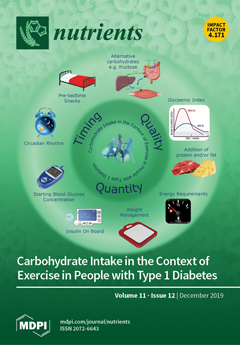This study aimed to examine the effects of four weeks of a low-carbohydrate diet (LC) and incorporated exercise training on body composition and cardiometabolic health. Fifty-eight overweight/obese Chinese females (age: 21.2 ± 3.3 years, body mass index (BMI): 25.1 ± 2.8 kg/m
2) were randomly assigned to the control group (CON,
n = 15), the LC control group (LC-CON,
n = 15), the LC and high-intensity interval training group (LC-HIIT,
n = 15), or the LC and moderate-intensity continuous training group (LC-MICT,
n = 13). Subjects consumed a four week LC, whereas LC-HIIT and LC-MICT received extra training 5 d/week (LC-HIIT: 10 × 6 s cycling interspersed with 9 s rest, MICT: 30 min continuous cycling at 50–60% VO
2peak). After intervention, the three LC groups demonstrated significant reductions in body weight (−2.85 kg in LC-CON, −2.85 kg in LC-HIIT, −2.56 kg in LC-MICT,
p < 0.001,
η2 = 0.510), BMI (
p < 0.001,
η2 = 0.504) and waist-to-hip ratio (
p < 0.001,
η2 = 0.523). Groups with extra training (i.e., LC-HIIT and LC-MICT) improved VO
2peak by 14.8 and 17.3%, respectively. However, fasting glucose and blood lipid levels remained unchanged in all groups. Short-term LC is a useful approach to improve body composition in overweight/obese Chinese females. Incorporated exercise training has no additional effects on weight loss, but has additional benefits on cardiorespiratory fitness, and HIIT is more time efficient than the traditional MICT (2.5 min vs. 30 min).
Full article






